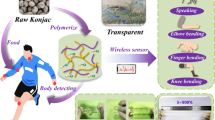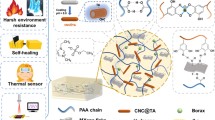Abstract
Ionic skin (I-skin) is an emerging skin-inspired sensor that has received increasing interest for the next-generation wearable electronics. However, profound challenges for I-skin remain in achieving multiple signal responses (e.g., strain, pressure, and humidity) and self-healability to fully mimic human skin. Herein, a Fe3+ ion-coordinated poly(acrylic acid) ionogel (PAIFe) with high stretchability, extreme temperature tolerance, and self-healing capability is prepared by a dynamic ionic cross-linking strategy. The ionic coordination in the PAIFe contributes to the formation of a highly dynamic network, achieving its high-efficient and reliable self-healing performance even at a low temperature of −20°C. Using of 1-butyl-3-methylimidazolium tetrafluoroborate ([BMIm][BF4]) as the solvent achieves a wide-temperature tolerance of the PAIFe under low and high temperatures. More interestingly, a humidity sensing function is realized in the PAIFe by skillfully utilizing the hygroscopic properties of [BMIm][BF4]. The resultant PAIFe is proof-of-concept demonstrated as a deformation-tolerant ionic conductor in a skin-inspired ionic sensor, showing a variety of sensory capabilities towards compression, strain and humidity.

摘要
离子皮肤(I-skin)作为一类新兴的类皮肤传感器, 在下一代可穿戴电子领域受到了越来越多的关注. 然而, I-skin在实现多重刺激响应(如应变、 压力和湿度等)和模仿皮肤的自修复功能等方面, 仍然面临着大的挑战. 本文通过动态离子交联策略, 制备了具有高可拉伸、 耐极端温度和可自修复的Fe3+离子配位聚丙烯酸离子凝胶(PAIFe). PAIFe中高度动态的离子配位作用和氢键交联结构, 使离子凝胶即使在−20°C低温条件下仍具有高效的自修复性能. 1-丁基-3-甲基咪唑四氟硼酸盐([BMIm][BF4])作为离子凝胶的分散介质, 赋予了PAIFe良好的抗冻/耐热性能. 更有趣的是, 通过巧妙地利用[BMIm][BF4]的吸湿特性, 实现了PAIFe对环境湿度的传感功能. 作为概念性验证, PAIFe作为可拉伸离子导体可组装成多模式感知的类皮肤传感器, 在湿度、 压缩和应变的不同外界刺激下表现出良好的响应能力.
Similar content being viewed by others
References
Wang M, Luo Y, Wang T, et al. Artificial skin perception. Adv Mater, 2021, 33: 2003014
Cao Z, Liu H, Jiang L. Transparent, mechanically robust, and ultrastable ionogels enabled by hydrogen bonding between elastomers and ionic liquids. Mater Horiz, 2020, 7: 912–918
Liu H, Zhang H, Han W, et al. 3D printed flexible strain sensors: From printing to devices and signals. Adv Mater, 2021, 33: 2004782
Niu S, Matsuhisa N, Beker L, et al. A wireless body area sensor network based on stretchable passive tags. Nat Electron, 2019, 2: 361–368
Gao Y, Wang Y, Xia S, et al. An environment-stable hydrogel with skin-matchable performance for human-machine interface. Sci China Mater, 2021, 64: 2313–2324
Yu HC, Zheng SY, Fang L, et al. Reversibly transforming a highly swollen polyelectrolyte hydrogel to an extremely tough one and its application as a tubular grasper. Adv Mater, 2020, 32: 2005171
Ren Y, Liu Z, Jin G, et al. Electric-field-induced gradient ionogels for highly sensitive, broad-range-response, and freeze/heat-resistant ionic fingers. Adv Mater, 2021, 33: 2008486
Bai J, Wang R, Ju M, et al. Facile preparation and high performance of wearable strain sensors based on ionically cross-linked composite hydrogels. Sci China Mater, 2021, 64: 942–952
Du W, Zhang J, Zhao Z, et al. Preparation of novel temperature-responsive double-network hydrogel reinforced with aramid nanofibers. Compos Commun, 2020, 22: 100438
Hao XP, Li CY, Zhang CW, et al. Self-shaping soft electronics based on patterned hydrogel with stencil-printed liquid metal. Adv Funct Mater, 2021, 31: 2105481
Lei W, Qi S, Rong Q, et al. Diffusion-freezing-induced microphase separation for constructing large-area multiscale structures on hydrogel surfaces. Adv Mater, 2019, 31: 1808217
Kim HJ, Paquin L, Barney CW, et al. Low-voltage reversible electro-adhesion of ionoelastomer junctions. Adv Mater, 2020, 32: 2000600
Zhang H, Cong Y, Osi AR, et al. Direct 3D printed biomimetic scaffolds based on hydrogel microparticles for cell spheroid growth. Adv Funct Mater, 2020, 30: 1910573
Pan L, Wang F, Cheng Y, et al. A supertough electro-tendon based on spider silk composites. Nat Commun, 2020, 11: 1332
Mao J, Zhao C, Li Y, et al. Highly stretchable, self-healing, and strain-sensitive based on double-crosslinked nanocomposite hydrogel. Compos Commun, 2020, 17: 22–27
Zhang W, Wu B, Sun S, et al. Skin-like mechanoresponsive self-healing ionic elastomer from supramolecular zwitterionic network. Nat Commun, 2021, 12: 4082
Guo Y, Bae J, Fang Z, et al. Hydrogels and hydrogel-derived materials for energy and water sustainability. Chem Rev, 2020, 120: 7642–7707
Zhou X, Guo Y, Zhao F, et al. Topology-controlled hydration of polymer network in hydrogels for solar-driven wastewater treatment. Adv Mater, 2020, 32: 2007012
Lei Z, Wu P. A highly transparent and ultra-stretchable conductor with stable conductivity during large deformation. Nat Commun, 2019, 10: 3429
Ren Y, Guo J, Liu Z, et al. Ionic liquid-based click-ionogels. Sci Adv, 2019, 5: eaax0648
Li T, Wang Y, Li S, et al. Mechanically robust, elastic, and healable ionogels for highly sensitive ultra-durable ionic skins. Adv Mater, 2020, 32: 2002706
Chang L, Song M, Zhang J, et al. Tunable ionic liquid-water separation enabled by bioinspired superwetting porous gel membranes. ACS Appl Mater Interfaces, 2019, 11: 44844–44850
Yiming B, Guo X, Ali N, et al. Ambiently and mechanically stable ionogels for soft ionotronics. Adv Funct Mater, 2021, 31: 2102773
Matsuda T, Nakajima T, Gong JP. Fabrication of tough and stretchable hybrid double-network elastomers using ionic dissociation of polyelectrolyte in nonaqueous media. Chem Mater, 2019, 31: 3766–3776
Zhao X, Chen F, Li Y, et al. Bioinspired ultra-stretchable and anti-freezing conductive hydrogel fibers with ordered and reversible polymer chain alignment. Nat Commun, 2018, 9: 3579
Zhang B, Zhang X, Wan K, et al. Dense hydrogen-bonding network boosts ionic conductive hydrogels with extremely high toughness, rapid self-recovery, and autonomous adhesion for human-motion detection. Research, 2021, 2021: 1–14
Ding Y, Zhang J, Chang L, et al. Preparation of high-performance ionogels with excellent transparency, good mechanical strength, and high conductivity. Adv Mater, 2017, 29: 1704253
Ho DH, Sun Q, Kim SY, et al. Stretchable and multimodal all graphene electronic skin. Adv Mater, 2016, 28: 2601–2608
Du G, Mao A, Yu J, et al. Nacre-mimetic composite with intrinsic self-healing and shape-programming capability. Nat Commun, 2019, 10: 800
Zhang Q, Deng YX, Luo HX, et al. Assembling a natural small molecule into a supramolecular network with high structural order and dynamic functions. J Am Chem Soc, 2019, 141: 12804–12814
Li Z, Zhu YL, Niu W, et al. Healable and recyclable elastomers with record-high mechanical robustness, unprecedented crack tolerance, and superhigh elastic restorability. Adv Mater, 2021, 33: 2101498
Wu X, Luo R, Li Z, et al. Readily self-healing polymers at subzero temperature enabled by dual cooperative crosslink strategy for smart paint. Chem Eng J, 2020, 398: 125593
Wang Y, Tebyetekerwa M, Liu Y, et al. Extremely stretchable and healable ionic conductive hydrogels fabricated by surface competitive coordination for human-motion detection. Chem Eng J, 2021, 420: 127637
Wu J, Wu Z, Xu H, et al. An intrinsically stretchable humidity sensor based on anti-drying, self-healing and transparent organohydrogels. Mater Horiz, 2019, 6: 595–603
Zheng N, Xu Y, Zhao Q, et al. Dynamic covalent polymer networks: A molecular platform for designing functions beyond chemical recycling and self-healing. Chem Rev, 2021, 121: 1716–1745
Fan C, Wang D, Huang J, et al. A highly sensitive epidermal sensor based on triple-bonded hydrogels for strain/pressure sensing. Compos Commun, 2021, 28: 100951
Yu X, Wang Y, Zhang H, et al. Ultrastretchable and stable conductive elastomer based on micro-ionicgel for wide-working-range sensors. ACS Appl Mater Interfaces, 2021, 13: 53091–53098
Zhu T, Feng Q, Liu S, et al. Metallogel-derived 3D porous carbon nanosheet composites as an electrocatalyst for oxygen reduction reaction. Compos Commun, 2020, 20: 100376
Shi P, Wang Y, Tjiu WW, et al. Highly stretchable, fast self-healing, and waterproof fluorinated copolymer ionogels with selectively enriched ionic liquids for human-motion detection. ACS Appl Mater Interfaces, 2021, 13: 49358–49368
Wang Y, Liu Y, Plamthottam R, et al. Highly stretchable and reconfigurable ionogels with unprecedented thermoplasticity and ultra-fast self-healability enabled by gradient-responsive networks. Macromolecules, 2021, 54: 3832–3844
Wei Y, Xiang L, Zhu P, et al. Multifunctional organohydrogel-based ionic skin for capacitance and temperature sensing toward intelligent skin-like devices. Chem Mater, 2021, 33: 8623–8634
Acknowledgements
This work was financially supported by the National Natural Science Foundation of China (21875033 and 52122303).
Author information
Authors and Affiliations
Contributions
Author contributions Wang Y, Zhang C and Liu T designed and performed the experiments and analyzed the data. Wang Y and Zhang C conceived the work and co-wrote the manuscript. Liu Y assisted with the strain, pressure and humidity sensing measurements. Hu N and Shi P assisted with the self-healing measurements. All authors have given approval to the final version of the manuscript.
Corresponding authors
Ethics declarations
Conflict of interest The authors declare that they have no conflict of interest.
Additional information
Supplementary information Supporting data are available in the online version of the paper.
Yufeng Wang is a PhD student at the College of Materials Science and Engineering, Donghua University. He joined Prof. Tianxi Liu’s group in 2017 and his research interest focuses on hydrogel and ionogel materials for ionic sensor and thermal management.
Chao Zhang is a professor at the College of Materials Science and Engineering, Donghua University. He received his PhD degree from Fudan University in 2013. His research interests include ionic conducting elastomers for wearable sensors, and photothermal-regulated aerogels for thermal management.
Tianxi Liu obtained his BSc degree from Henan University (1992) and PhD degree from Changchun Institute of Applied Chemistry, Chinese Academy of Sciences (1998). He is currently a full professor at the College of Materials Science and Engineering, Donghua University. His main research interests include polymer nanocomposites, organic/inorganic hybrid materials, nanofibers and their composites, and advanced energy materials for energy conversion and storage.
Supplementary Material
40843_2021_1977_MOESM1_ESM.pdf
Highly stretchable and self-healable ionogels with multiple sensitivity towards compression, strain and moisture for skin-inspired ionic sensors
Rights and permissions
About this article
Cite this article
Wang, Y., Liu, Y., Hu, N. et al. Highly stretchable and self-healable ionogels with multiple sensitivity towards compression, strain and moisture for skin-inspired ionic sensors. Sci. China Mater. 65, 2252–2261 (2022). https://doi.org/10.1007/s40843-021-1977-5
Received:
Accepted:
Published:
Issue Date:
DOI: https://doi.org/10.1007/s40843-021-1977-5




